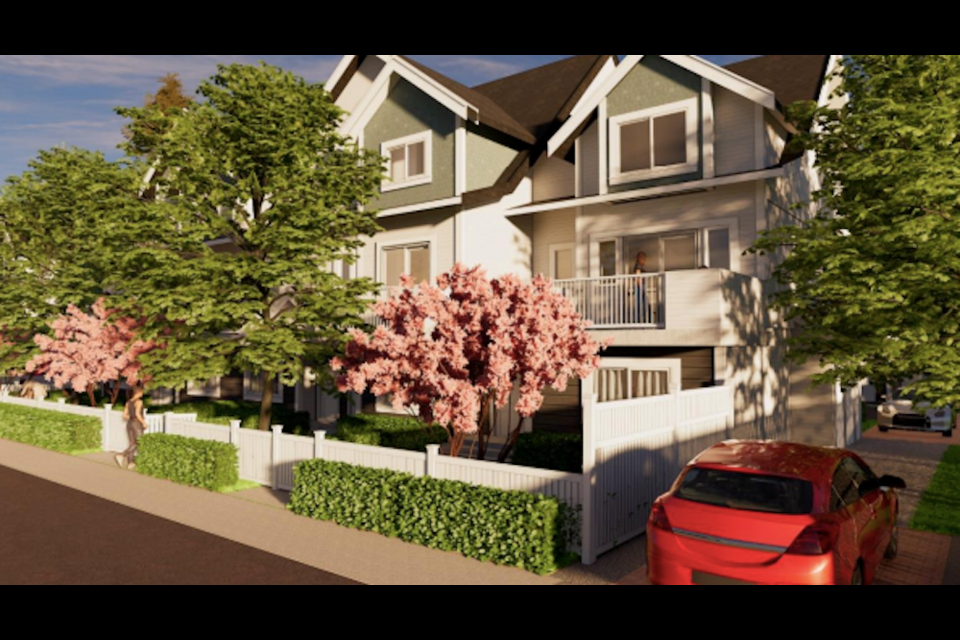Port Coquitlam has a role to play in meeting a huge demand for housing in Metro Vancouver, said Mayor Brad West in approving a new 23-unit townhouse project for the city's north side.
Located at 1759, 1771, 1775 and 1781 Prairie Ave, the proposal by CityState Consulting will provide three-bedroom units, with sizes ranging from 1,560 to 1,810 sq. ft. for families, as well as a children's play area, and retain nine mature trees.
"Metro Vancouver is going to see a significant population increase over the next several decades and there is no stopping people from coming to Port Coquitlam, it’s a great place to live," said Mayor West as council unanimously approved the 23-unit townhouse development on four single family lots.
"Every city is expected to accept a share of the population growth that is coming," said West.
He said the proposal fits in with the city's Official Community Plan and the local context.
However, the project received criticism from residents who turned out for the Dec. 6 public hearing, including concerns about traffic and the impact of an extra four units of density on the neighbourhood.
Traffic and density concerns
"I’m concerned with the amount of traffic you’re going to dump on a lane that has typically not seen any traffic in 35 years," said Gord Sherwood.
He said the back lane between Prairie Avenue and Salisbury Avenue is used by pedestrians as well as cars and should be lit if it's going to accommodate more traffic.
Sherwood, who built his house 10 years ago, said he disagreed with the increased density variance of four additional units on the property.
"Bonus densities are basically a carrot hanging in front of everybody's nose — a $235,000 carrot," Sherwood said, referring to money the developer will pay as a density bonus for city amenities and affordable housing.
Other residents raised concerns about the impact of more residents on the neighbourhood and services such as hospitals, ambulance, fire and how the environment and animals will be affected.
Worried concerns fall on deaf ears
One resident said the city's notification process, which gave the wrong date for the meeting before it was changed, might have prevented more people from sharing their concerns at the meeting.
"The concerns of some residents, I hope they don’t fall on deaf ears," said the resident, who lives on Salisbury Avenue.
Council was told that the density of the project is less than that of other nearby townhouse developments.
Carola Thompson, of CityState Consulting, said the project is the equivalent of 5.75 units per single family lot (with the lot sized at 8,700 sq. ft.) compared to six units per lot and 6.5 units per lot in other developments nearby.
She noted that a visitor's parking space has been added to accommodate neighbour's parking concerns, nine trees will be retained and the development will achieve a high level of energy efficiency through Built Green Gold certification, which is also Step 3 in the B.C. Energy Step Code.
Installing lighting in the lane to provide enhanced safety was supported by several councillors, including Coun. Dean Washington.
"I would suggest you really explore it, I’m sure there would be support on this council," he told staff. who agreed lighting lanes used for access to multi-family homes could be considered in future.
Getting into the real estate market
Meanwhile, several councillors said they were supportive of the project; Coun. Nancy McCurrach said it was "in the right place."
Coun. Darrell Penner said it's been several years since the Official Community Plan called for more density in the area and at the time few people expressed concerns.
"We got virtually got nothing back from the community on concerns about this area, [and] we’re going well 'OK that looks like that’s going to work,'" said Penner.
"Fast forward, many things have changed since then and the things that have changed has been the greater need for housing and choices in housing forms."
Coun. Paige Petriw noted that her family is among the demographic that couldn't afford to purchase a single family home and bought a townhouse, similar to the ones being proposed, and began to build up equity.
"I’m kind of a real life example of how families get into the market with this type of housing," Petriw said.
In reiterating his support for the development, Mayor West noted that Premier David Eby has put municipalities on notice that governments may step in if housing targets aren't met.
"From my perspective, on balance, it's a good development in the right spot, consistent with the city's OCP with a very modest increase in units at a time when cities are increasingly under the gun."





